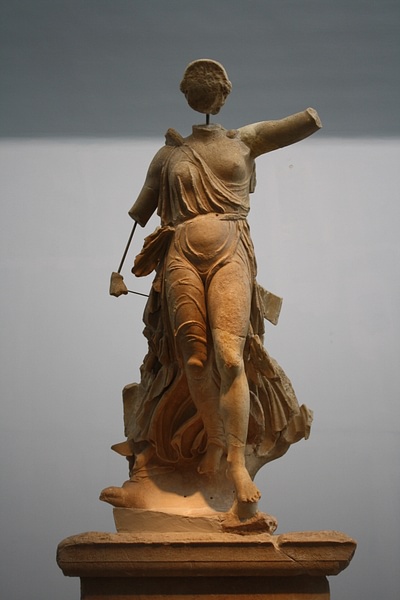
The ancient Greek goddess Nike was the personification of the ideal of victory. Such personifications of ideal terms were common in ancient Greek culture; other examples include Wisdom, Knowledge, and Justice. Unlike other gods in the Greek pantheon, such personifying deities were not usually given human personalities and histories. For this reason, little is said about Nike in Greek culture beyond that her mother was Styx (daughter of Ocean) and her father was Pallas, the Titan. She had three sisters, also personified deities: Zelus (Rivalry), Cratos (Supremacy), and Bia (Force) who, with Nike, were always seated by mighty Zeus on Mt. Olympus.
The goddess was a popular figure in ancient Greek art, appearing in sculpture, on pottery, and on coins. Usually fitting Hesiod's description as 'beautiful-ankled Nike', she is depicted with wings and often carries before her a wreath of victory, which she presents either to other gods or to victorious heroes and athletes. The oldest surviving winged Nike in sculpture is from Delos and dates to 550 BCE and was most probably sculpted by Archermos. The statue is in the Archaic style and strikes the typical pose of the period with bent knees and running. On Attic 5th to 4th century BCE pottery, Nike also often rides a chariot or sometimes stands next to an altar or a sacrificial bull.
One of the goddess Athena's most common epithets was Athena Nike and a temple to Athena as Victory was built on the Acropolis of Athens in the late 420's BCE. Bronze akroteria (added decoration) on the corners and central ridge of the temple roof represented Nike, and the temple itself was surrounded by a balustrade decorated with a frieze which depicted figures of Nike leading bulls to sacrifice and erecting various trophies such as weapons and armour.
Nike also appeared in decorative sculpture on other buildings, both in friezes and on many temple roofs as an akroteria and on many coins from Thrace to Macedonia, for example, she appears on a silver decadrachm of Syracuse (Sicily) where she is crowning a charioteer (c. 400 BCE). Statues of Nike were also set up to commemorate military victories, a famous example being the 1.4 m tall Nike (490-480 BCE) on the acropolis dedicated to the general Kallimachos who was killed at the battle of Marathon where the Greeks were victorious over the Persians.
In antiquity, the most celebrated representations of Nike were as part of the great 5th century BCE statues of the deities Athena and Zeus which stood, respectively, within the Parthenon of Athens and the Temple of Zeus at Olympia. These larger-than-life chryselephantine statues were made from an inner core of wood sumptuously covered in carved ivory and burnished gold. Face, torso, legs, and arms were in carved ivory and hair and clothes were made of sheet gold. In both cases, the god held in their right hand a statue of Nike, always closely associated with Athena, and in the case of Zeus and the pan-Hellenic games of Olympia, significant in her role as bestower of prizes. The statue of Zeus was considered one of the Seven Wonders of the Ancient World, and the father of the gods is shown seated on a massive, richly decorated throne with more figures of Nike on its legs. Neither statue survives but descriptions by Pausanias, smaller Roman copies, and coin designs help give us a glimpse of the magnificence that we have lost.
A third representation which must have struck a certain degree of awe into the ancients was the statue of Nike by Paionios, which stood on a nine metre tall triangular pedestal just outside the Temple of Zeus at Olympia. Dedicated to the sanctuary by the Messenians and Naupaktians following their victory over the Spartans at Sphakteria in 424 BCE, the Nike itself was three metres tall and would have dominated all of the other dedications at the site. The statue is sculpted in the rich style popular in the late 5th century BCE, and with a chiton that is at once billowing and clinging and with wings widespread, the impression is that the goddess has just that moment softly alighted onto the pedestal.





